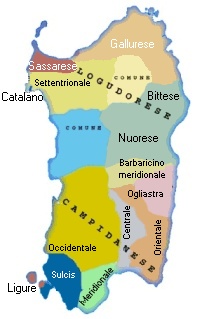 Every geographic zone of Sardinia had a historical evolution with different
linguistic influences that characterize still today the different varieties
of the Sardinian language. Sounds and musicality are constant.
Every geographic zone of Sardinia had a historical evolution with different
linguistic influences that characterize still today the different varieties
of the Sardinian language. Sounds and musicality are constant.
The Sardinian language is considered the most characteristic of Latin
languages; in fact, while the other neo-Latin tongues have been elaborated
during the centuries, the Sardinian one in its isolation, preserves the
original peculiarity of the original languages - Greek and Latin.
The year 1700 marks the passage of Sardinia from the Spanish dominion to the
Piedmonts and in the first half of the century persists a bilingual
situation: people speak Sardinian and Spanish. Later people are obliged to
use Italian as the official language and simultaneously the use of Latin
diminuished. The interest for the Sardinian language continues also in the
18th century while Italian spread all over the country. The real inversion
of tendency begins after 1861 with the Italian unity. Meanwhile Italian
becomes more and more ufficial. The dialect, however, was still diffused.
Sardinian means various dialectal forms excluding the dialects of Alghero,
Catalan linguistics ilse, and of Carloforte and Calasetta, Genoan
linguistics isle.
The Sardinian language has five main varieties:
- Nuorese
- Gallurese
- Sassarese
- Logudorese
- Campidanese
|

